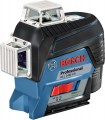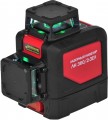Measurement range (with receiver)
The longest measurement range provided by a laser level (see “Type”) when using a special receiver with a photocell.
Thanks to its sensitivity, such a receiver is able to respond even to a weak laser beam, the mark from which is no longer visible to the naked eye; At the same time, the area of the photocell is quite large, and special indicators make it possible to determine the exact position of the mark. Among other things, this significantly expands the range of action of the level - the measurement range with a receiver is usually several times greater than without it. On the other hand, such equipment inevitably affects the overall cost of the device; and in some models the receiver
is not included in the package at all; it must be purchased separately. However, the second option also has its advantages: you do not need to immediately pay for an additional accessory, it can be purchased later, when a real need arises, while some models allow you to choose the optimal receiver model from several options at your discretion.
Note that the receiver can be useful not only for increasing range; These points are described in detail in paragraph “Included parts”.
Leveling time
Approximate time it takes for the self-levelling mechanism to bring the level to a perfectly level position.
For more information on such a mechanism, see Self-Level Limits. And the actual time of its alignment directly depends on the actual deviation of the device from the horizontal. Therefore, in the characteristics, usually, the maximum alignment time is given — that is, for the situation when in the initial position the device is tilted to the maximum angle along both axes, longitudinal and transverse. Since the levels are far from being installed in this position, in fact the speed of bringing to the horizontal is often higher than the claimed one. Nevertheless, it makes sense to evaluate different models precisely according to the figures stated in the characteristics — they allow you to estimate the maximum amount of time that will have to be spent on alignment after the next movement of the device. As for specific indicators, they can vary from 1.5 – 2 s to 30 s.
Theoretically, the shorter the alignment time, the better, especially if there are large volumes of work ahead with frequent movements from place to place. However, in fact, when comparing different models, it is worth considering other points. First, we reiterate that the rate of leveling is highly dependent on the leveling limits; after all, the greater the deviation angles, the more time it usually takes for the mechanism to return the level to the horizontal. So, to directly compare w...ith each other in terms of the speed of self-leveling, it is mainly those devices in which the permissible deviation angles are the same or differ slightly. Secondly, when choosing, it is worth considering the specifics of the proposed work. So, if the device is to be used frequently on very uneven surfaces, then, for example, a model with a leveling time of 20 s and self-levelling limits of 6 ° will be a more reasonable choice than a device with a time of 5 s and limits of 2 °, since in In the second case, a lot of time will be spent on the initial (manual) installation of the device. And for more or less even horizontal planes, on the contrary, a faster device may be the best option.
Operating temperature
The temperature range at which the device is guaranteed to work for a sufficiently long time without failures, breakdowns and exceeding the measurement error specified in the characteristics. Note that we are talking primarily about the temperature of the device case, and it depends not only on the ambient temperature — for example, a tool left in the sun can overheat even in fairly cool weather.
In general, you should pay attention to this parameter when you are looking for a model for working outdoors, in unheated rooms and other places with conditions that are significantly different from indoor ones; in the first case, it makes sense to also make sure that there is dust and water protection (see "Protection class"). On the other hand, even relatively simple and "myopic" levels / rangefinders usually tolerate both heat and cold quite well.
Tripod thread
The standard size of the thread used to mount the level/rangefinder on a tripod (if available). This option can be useful if you already have a surveying tripod that you want to use with the tool.
The most popular options in modern devices are 1/4" and 5/8". It is worth noting that 1/4" is a standard size for
photographic equipment - accordingly, levels with such a thread can be installed even on ordinary
photographic tripods.
Auto power off
The ability
to automatically turn off the device after a certain time. This function is found in those types of measuring instruments that require power for operation — first of all, we are talking about laser rangefinders, however, this list may also include levels (see "Type"), both laser and optical with additional digital modules . The main purpose of auto-shutdown is to save electricity: after all, almost all such devices have autonomous power sources (see "Power"), the charge of which is not infinite. Forgetting to turn off the device, you may encounter an unpleasant situation: the batteries are dead, but there are no fresh ones at hand; auto-off prevents these situations and generally increases the operating time without changing batteries or recharging the battery. In addition, this feature is also useful from a safety point of view: automatic laser shutdown reduces the likelihood that its beam will accidentally fall into the eyes of someone around (including a forgetful operator).
In some models, auto-shutdown works on the entire electronics, in others it may be possible to turn off the laser first (as the most energy-intensive and unsafe part), and only after a while — all other electronic circuits.
Auto power off
The time after which the device turns off by itself completely if the user does not perform any action.
See above for more information on auto power off; and his time has a double meaning. On the one hand, if this time is short, then the idle time of the device will be minimal, which helps to save energy. On the other hand, too frequent auto-shutdown (with subsequent switching on for work) is also undesirable — it increases the wear of components and reduces the resource, and it is not always convenient for the user. So manufacturers choose the time, taking into account the balance between these moments, as well as the general class and purpose of the device. So, in some rangefinders, this indicator does not even reach a minute, although in most such devices it is in the range from 3 to 8 minutes; and in some professional devices (primarily levels), the auto-off time can be 30 minutes or more (up to 3 hours).
Diode emission
The wavelength of the radiation emitted by the LED of the level or rangefinder; this parameter determines primarily the colour of the laser beam. The most widespread in modern models are LEDs with a wavelength of about 635 nm — at a relatively low cost, they provide bright red radiation, giving a well-visible projection. There are also green lasers, usually at 532 nm — the marks from them are even better visible, but such LEDs are quite expensive and rarely used. And radiation with a wave longer than 780 nm belongs to the infrared spectrum. Such a laser is invisible to the naked eye and is poorly suited for leveling, but it can be used in rangefinders — of course, with a viewfinder (see "Type" for more details).
Vertical projections
The number of vertical projections issued by the laser level during operation.
Most modern levels are designed for a strictly defined position when working; accordingly, the
projection is called vertical, carried out from top to bottom relative to the standard position of the device. If there are several such planes, the level can be used for two or even three walls at once — this is useful, for example, for the simultaneous work of several people. At the same time, there are portable devices that can be used in different positions; for them, the main working plane is called vertical, although during operation it can be located both horizontally and at an angle, depending on specific tasks. Also note that the vertical projection can also give a horizontal line — for example, when installing a level on the floor.
Note that the number of projections is calculated not by geometric planes, but by individual laser elements, each of which is responsible for its own “work area”. For example, if the level has two vertical elements located at opposite ends and directed in different directions, they are considered as two projections even if these projections lie in the same plane.
Bluetooth
The presence
of a Bluetooth module allows you to broadcast the measurements to the connected device. Thus, you can make the device as compact as possible, and read the received data directly from the phone. And in the era of high technology and the ability to control the phone with any device, such a decision looks quite reasonable.

